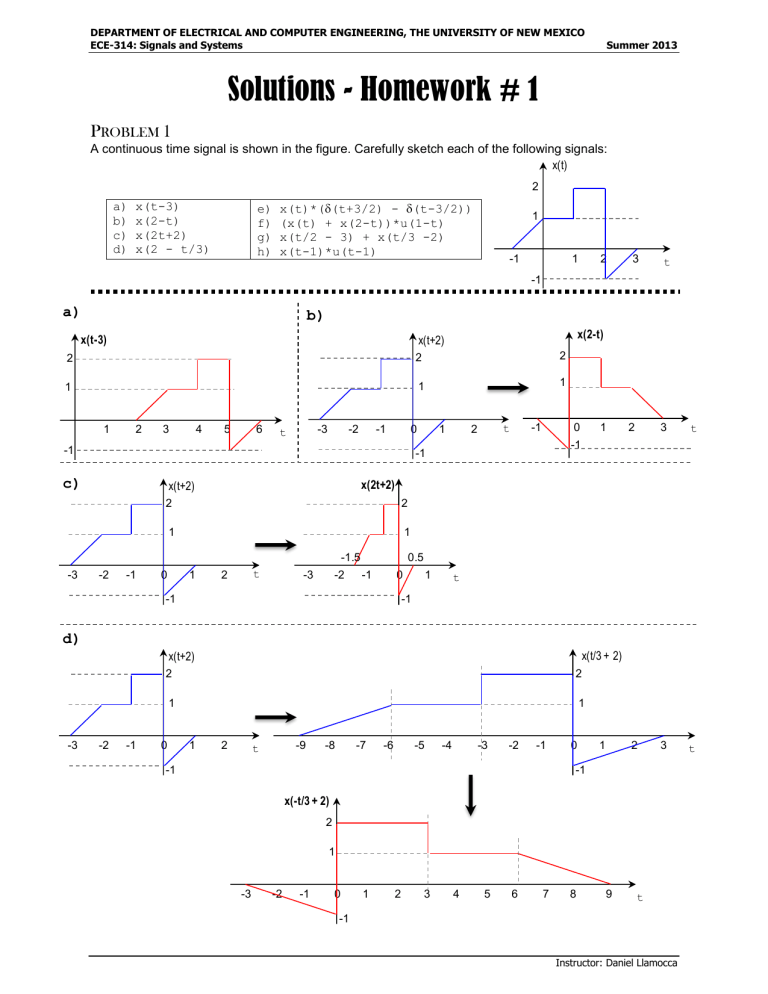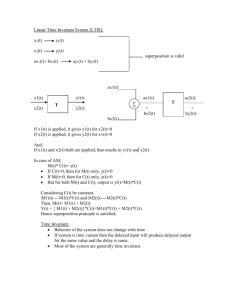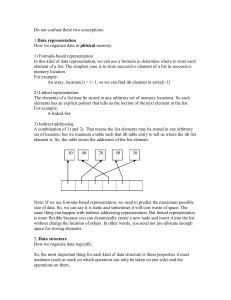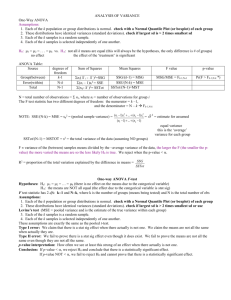Solutions - Homework 1
advertisement

DEPARTMENT OF ELECTRICAL AND COMPUTER ENGINEERING, THE UNIVERSITY OF NEW MEXICO
ECE-314: Signals and Systems
Summer 2013
Solutions - Homework # 1
PROBLEM 1
A continuous time signal is shown in the figure. Carefully sketch each of the following signals:
x(t)
2
a)
b)
c)
d)
x(t-3)
x(2-t)
x(2t+2)
x(2 - t/3)
e)
f)
g)
h)
x(t)*((t+3/2) - (t-3/2))
(x(t) + x(2-t))*u(1-t)
x(t/2 - 3) + x(t/3 -2)
x(t-1)*u(t-1)
1
-1
1
2
3
t
-1
a)
b)
x(t-3)
x(2-t)
x(t+2)
2
2
2
1
1
1
1
2
3
4
5
6
-3
t
-2
-1
0
-1
t
2
-1
0
-1
-1
c)
-2
-1
2
2
1
1
0
1
1
2
3
t
2
3
t
x(2t+2)
x(t+2)
-1.5
-3
1
t
2
-3
-2
0.5
-1
0
-1
1
t
-1
d)
x(t/3 + 2)
x(t+2)
-3
-2
-1
2
2
1
1
0
1
2
-9
t
-8
-7
-6
-5
-4
-3
-2
-1
-1
0
1
-1
x(-t/3 + 2)
2
1
-3
-2
-1
0
1
2
3
4
5
6
7
8
9
t
-1
Instructor: Daniel Llamocca
DEPARTMENT OF ELECTRICAL AND COMPUTER ENGINEERING, THE UNIVERSITY OF NEW MEXICO
ECE-314: Signals and Systems
e)
Summer 2013
f)
x(t)
x(2-t)
x(t)
2
2
2
1
1
1
-1
1
2
3
-1
t
0
1
2
t
3
-1
-1
-1
1
2
3
t
-1
x(t) + x(2-t)
x(t)*((t+3/2) - (t-3/2)
2
3
1
2
2
1
1
-1
1
2
3
u(1-t)
t
-1
-1
-2
1
2
3
-1
t
1
2
t
-1
x(2)(t-3/2)
(x(t) + x(2-t))*u(1-t) 3
2
1
-1
1
2
3
t
h)
x(t-1)
x(t-1)*u(t-1)
u(t-1)
2
2
2
1
1
1
1
-1
2
3
4
5
t
1
2
3
1
t
2
3
4
t
-1
Instructor: Daniel Llamocca
DEPARTMENT OF ELECTRICAL AND COMPUTER ENGINEERING, THE UNIVERSITY OF NEW MEXICO
ECE-314: Signals and Systems
Summer 2013
g)
x(t-2)
x(t/3-2)
2
2
1
1
1
2
3
4
5
6 t
-1
1
3
4
5
6
7
2
3
4
5
6
7
4
5
6
7
8
9
10
11
12
9
10
11
12
9
10
11
12
13
14
15 t
13
14
15 t
-1
x(t-3)
x(t/2-3)
2
2
1
1
1
-1
2
2
3
4
5
6 t
1
8
t
-1
x(t/3-2) + x(t/2 - 3)
4
3
2
1
1
2
3
8
-1
Instructor: Daniel Llamocca
DEPARTMENT OF ELECTRICAL AND COMPUTER ENGINEERING, THE UNIVERSITY OF NEW MEXICO
ECE-314: Signals and Systems
Summer 2013
PROBLEM 2
The discrete-time signals x1[n] and x2[n] are shown in the figure. Carefully sketch each of the following
signals:
x1[n]
3
2
1
n
-6
-5
-4
-3
-2
-1
0
1
2
3
4
5
6
2
3
4
5
6
x2[n]
1
n
-6
a)
b)
c)
d)
a)
-5
-4
-3
-2
0
-1
1
x1[3n] + x2[n-2]
x1[2n] - u[n-2]
0.5*x1[n] + (-1)n x1[n]
x1[n]*u[1-n]
e)
f)
g)
h)
x1[2n-3]
x1[2n-1] + u[2n+3]
x1[n-1][n-3]
2n x1[n-1]
b)
x1[3n]
x1[2n]
3
3
2
2
1
1
n
-3
-2
-1
0
1
2
3
4
5
n
6
-3
-2
-1
0
n
-1
0
3
4
5
6
1
1
-2
2
u[n-2]
x2[n-2]
-3
1
1
2
3
4
5
6
...
...
-3
7
-2
-1
0
1
2
3
4
5
6
5
6
7
x1[2n] - u[n-2]
x1[3n] + x2[n-2]
4
2
3
1
...
2
n
-3
1
-2
-1
0
1
2
3
4
-1
n
-3
-2
-1
0
n
1
2
3
4
5
6
7
Instructor: Daniel Llamocca
7
...
DEPARTMENT OF ELECTRICAL AND COMPUTER ENGINEERING, THE UNIVERSITY OF NEW MEXICO
ECE-314: Signals and Systems
0.5*x1[n]
c)
d)
2
1.5
u[1-n]
1
1
0.5
-4
-3
-2
-1
0
Summer 2013
n
1
2
3
4
5
...
...
-4
-5
-3
-2
-1
0
(-1)nx1[n]
1
2
3
4
x1[n]
3
3
2
2
1
1
n
n
-4
-3
-2
-1
0
1
2
3
4
5
-5
-4
-3
-2
-1
0
1
2
3
4
-1
x1[n]*u[1-n]
3
-3
2
0.5*x1[n] + (-1)nx1[n]
3
1
n
2
-5
-4
-3
-2
-1
0
1
2
3
4
1
n
-4
-3
-2
-1
-0.5
0
1
2
3
4
5
-1
-1.5
-2
e)
x1[n-3]
x1[2n-3]
3
3
2
2
1
1
n
n
-1
0
1
2
3
4
5
6
7
8
-1
0
1
2
3
4
5
6
7
Instructor: Daniel Llamocca
n
DEPARTMENT OF ELECTRICAL AND COMPUTER ENGINEERING, THE UNIVERSITY OF NEW MEXICO
ECE-314: Signals and Systems
f)
x1[n-1]
Summer 2013
x1[2n-1]
3
3
2
2
1
1
n
n
-3
-2
-1
0
1
2
3
4
5
-3
-2
-1
0
u[n+3]
-4
3
4
5
1
...
...
-2
2
u[2n+3]
1
-3
1
-1
0
1
2
3
4
...
n
5
-3
...
-2
-1
0
1
2
3
4
n
5
x1[2n-1] + u[2n+3]
3
2
1
...
-3
g)
-2
-1
...
0
1
2
3
4
n
5
h)
2nx1[n-1]
x1[n-1]
3
48
...
1
16
...
2
n
-2
-1
0
1
2
3
4
5
4
x1[n-1][n-3]
3
3
2
2
1
1
3/4
n
-3
-2
-1
...
...
-3
0
1
2
3
4
5
-3
-2
-1
0
n
1
2
3
4
5
Instructor: Daniel Llamocca
6
DEPARTMENT OF ELECTRICAL AND COMPUTER ENGINEERING, THE UNIVERSITY OF NEW MEXICO
ECE-314: Signals and Systems
Summer 2013
PROBLEM 3
Determine whether the following signals are periodic, and for those which are, find the fundamental
period (T for continuous time signals and N for discrete-time signals) and the fundamental angular
frequencies ( for continuous time signals and for discrete-time signals). You must specify the units of
these quantities.
a)
b)
c)
d)
e)
f)
x[n]
x[n]
x(t)
x[n]
x(t)
x(t)
=
=
=
=
=
=
cos((8/15)*n)
sin((7/15)*n)
sin(2t) + cos(3t)
sin((1/5)*n)*sin((1/3)*n)
sin(t)u(t-1)
sin(t)u(t) + sin(-t)*u(-t)
a) N = 2m/(8/15) N = (15/4)m
Then, we choose m = 4 N = 15 samples, = 2/15 rads/sample.
b) N = 2m/(7/15) N = (30/7)m
Then, we choose m = 7 N = 30 samples, = /15 rads/sample.
c) For periodicity: x(t) = x(t + T)
sin(2t) + cos(3t) = sin(2t + 2T) + cos(3t + 3T)
We need: 2T = 2k, and 3T = 2r, where k,r are integers
Then, we see that: T = k = (2/3)r 3k = 2r
The smallest numbers k,r that satisfy this condition are k = 2, r = 3.
Then, the signal x(t) is periodic with period T = 2 secs, = 1 rad per second
d) For periodicity: x[n] = x[n + N]
sin(n/5)sin(n/3) = sin(n/5 + N/5)sin(n/3 + N/3)
We need: N/5 = 2k, and N/3 = 2r, where k,r are integers
Then, we see that: N = 10k = 6r 5k = 3r
The smallest numbers k,r that satisfy this condition are k = 3, r = 5.
Then, the signal x[n] is periodic with period N = 30 samples, = /15 rads/sample.
* Optional:
If we notice that: sin(n/5)sin(n/3) = sin(n/5 + k)sin(n/3 + r)
Then, we need: N/5 = k, and N/3 = r, where k,r are integers
Then, k=3, r=5, and N = 5k = 3r = 15 samples, = 2/15 rads/sample.
e) The signal is zero only for t 1. Therefore, x(t) is non-periodic.
f) The signal is non-periodic: x(t) x(t +T)
x(t)
x(t)
...
...
t
T
T
x(t+T)
Instructor: Daniel Llamocca
DEPARTMENT OF ELECTRICAL AND COMPUTER ENGINEERING, THE UNIVERSITY OF NEW MEXICO
ECE-314: Signals and Systems
Summer 2013
PROBLEM 4
The systems that follow have input x(t) or x[n] and output y(t) or y[n] respectively. For each
system, determine (and justify) whether it is (i) memoryless, (ii) stable, (iii) causal, (iv) linear, and (v) time
invariant. Recall that to disprove that a system has a certain property, all you need is to come up with a
counter-example.
x(t)
a)
b)
c)
d)
e)
f)
y(t)
y(t)
y[n]
y[n]
y[n]
y[n]
=
=
=
=
=
=
y(t)
CT
SYSTEM
x[n]
DT
SYSTEM
y[n]
cos(x(t))
x(t/2)
3*x[n]u[n]
log2(|x[n]|)
x[n] + x[n-1] + x[n+2]
2n x[n]
a) y(t) = cos(x(t))
It is memoryless: it only depends on the current value of the signal.
Stability:
If |x(t)| Mx < , t it should be that |y(t)| My < , t
|y(t)| = |cos(x(t)| |y(t)| = |cos(x(t)| 1
Therefore, the system is stable.
Causality: It is causal, because it does not depend on future values of the input x(t).
Linearity:
If the input to the system is axA(t) + bxB(t), where a,b, are real numbers, then the output to
the system should be ayA(t) + byB(t), where yA(t), yB(t) are the responses of the system
to xA(t) and xB(t) respectively.
If the input to the system is axA(t) + bxB(t), then:
y(t) = cos(axA(t) + bxB(t))
ayA(t) + byB(t) = acos(xA(t)) + bcos(xB(t))
We see that y(t) a(yA(t)) + b(yB(t)). Thus, the system is NOT linear.
Time invariance:
We have a system y(t) = H(x(t)). The response of the system to a shifted input x(t-k)
should be the same as if the output y(t) has been shifted by k, i.e., y(t-k):
x(t-k)
x(t)
y1(t)
Sk
H
these two should
be the same
x(t)
H
y(t)
Sk
y(t-k)
Response of system to shifted input x(t-k): y1(t) = cos(x(t-k))
Output y(t) shifted by k:
y(t-k) = cos(x(t-k))
We see that y(t-k) = y1(t). Thus, the system is time invariant.
Instructor: Daniel Llamocca
DEPARTMENT OF ELECTRICAL AND COMPUTER ENGINEERING, THE UNIVERSITY OF NEW MEXICO
ECE-314: Signals and Systems
Summer 2013
b) y(t) = x(t/2)
It is NOT memoryless: y(2) = x(1), y(3) = x(1.5).
Stability:
If |x(t)| Mx < , t it should be that |y(t)| My < , t
|y(t)| = |x(t/2)| |x(t)|
Therefore, the system is stable.
Causality: It is NOT causal, because it depends on future values of the input x(t):
For example: y(-1) = x(-0.5), y(-4) = x(-2).
Linearity:
If the input to the system is axA(t) + bxB(t), where a,b, are real numbers, then the output to
the system should be ayA(t) + byB(t), where yA(t), yB(t) are the responses of the system
to xA(t) and xB(t) respectively.
If the input to the system is axA(t) + bxB(t), then:
y(t) = axA(t/2) + bxB(t/2))
ayA(t) + byB(t) = axA(t/2) + bxB(t/2)
We see that y(t) = ayA(t) + byB(t). Thus, the system is linear.
Time invariance:
We have a system y(t) = H(x(t)) = x(t/2). The response of the system to a shifted input
x(t-k) should be the same as if the output y(t) has been shifted by k, i.e., y(t-k).
x(t)
Sk
x(t)
H
x(t-k)
y(t)=x(t/2)
H
Sk
y1(t)= x(t/2-k)
y(t-k)= x((t-k)/2)
Response of system to shifted input x(t-k): y1(t) = x(t/2-k)
Output y(t) shifted by k:
y(t-k) = x((t-k)/2)
We see that y(t-k) y1(t). Thus, the system is NOT time invariant.
c) y[n] = 3*x[n]u[n]
It is memoryless: it only depends on the current sample of the signal.
Stability:
If |x[n]| Mx < , n it should be that |y[n]| My < , n
|y[n]| = |3x[n]u[n]| |3x[n]|
Therefore, the system is stable.
Causality: It is causal, because it does not depend on future samples of the input x[n].
Linearity:
If the input to the system is axA[n] + bxB[n], where a,b, are real numbers, then the output to
the system should be ayA[n] + byB[n], where yA[n], yB[n] are the responses of the system
to xA[n] and xB[n] respectively.
Instructor: Daniel Llamocca
DEPARTMENT OF ELECTRICAL AND COMPUTER ENGINEERING, THE UNIVERSITY OF NEW MEXICO
ECE-314: Signals and Systems
Summer 2013
If the input to the system is axA[n] + bxB[n], then:
y[n] = 3(axA[n] + bxB[n])u[n]
y[n] = 3(axA[n]u[n]) + 3(bxB[n])u[n])
ayA[n] + byB[n] = a*3*xA[n]u[n] + b*3*xB[n]
We see that y[n] = a(yA[n]) + b(yB[n]). Thus, the system is linear.
Time invariance:
We have a system y[n] = H(x[n]). The response of the system to a shifted input x[n-k]
should be the same as if the output y[n] has been shifted by k, i.e., y[n-k]:
x[n]
Sk
x[n]
H
x[n-k]
y[n]=3x[n]u[n]
H
y1[n]= 3x[n-k]u[n]
Sk
y[n-k]=3x[n-k]u[n-k]
Response of system to a shifted input x[n-k]: y1[n] = 3x[n-k]u[n]
Output y[n] shifted by k:
y[n-k] = 3x[n-k]u[n-k]
We see that y[n-k] y1[n]. Thus, the system is NOT time invariant.
d) y[n] = log2(|x[n]|)
It is memoryless: it only depends on the current sample of the signal.
Stability:
If |x[n]| Mx < , n it should be that |y[n]| My < , n
|y[n]| = |log2|x[n]||
When x[n] approaches 0, log2(|x[n]|) approaches towards minus infinity. Thus, the system
is NOT stable.
Causality: It is causal, because it does not depend on future samples of the input x[n].
Linearity:
If the input to the system is axA[n] + bxB[n], where a,b, are real numbers, then the output to
the system should be ayA[n] + byB[n], where yA[n], yB[n] are the responses of the system
to xA[n] and xB[n] respectively.
If the input to the system is axA[n] + bxB[n], then:
y[n] = log2(|axA[n] + bxB[n]|)
ayA[n] + byB[n] = alog2(|xA[n]|) + blog2(|xB[n]|)
We see that y[n] a(yA[n]) + b(yB[n]). Thus, the system is NOT linear.
Time invariance:
We have a system y[n] = H(x[n]). The response of the system to a shifted input x[n-k]
should be the same as if the output y[n] has been shifted by k, i.e., y[n-k]:
Response of system to a shifted input x[n-k]: y1[n] = log2(|x[n-k]|)
Output y[n] shifted by k:
y[n-k] = log2(|x[n-k]|)
We see that y[n-k] = y1[n]. Thus, the system is time invariant.
Instructor: Daniel Llamocca
DEPARTMENT OF ELECTRICAL AND COMPUTER ENGINEERING, THE UNIVERSITY OF NEW MEXICO
ECE-314: Signals and Systems
Summer 2013
e) y[n] = x[n] + x[n-1] + x[n+2]
It is NOT memoryless: it depends on previous and future samples of the signal.
Stability:
If |x[n]| Mx < , n it should be that |y[n]| My < , n
|y[n]| = |x[n] + x[n-1] + x[n+2]| |x[n]| + |x[n-1]| + |x[n+2]|
If |x[n]| Mx < , n |x[n-k]| Mx < , n
Then:
|y[n]| Mx + Mx + Mx
|y[n]| 3Mx
Therefore, the system is stable.
Causality: It is NOT causal, because it depends on future samples of the input x[n].
Linearity:
If the input to the system is axA[n] + bxB[n], where a,b, are real numbers, then the output to
the system should be ayA[n] + byB[n], where yA[n], yB[n] are the responses of the system
to xA[n] and xB[n] respectively.
If the input to the system is axA[n] + bxB[n], then:
y[n] = (axA[n] + bxB[n]) + (axA[n-1] + bxB[n-1]) + (axA[n+2] + bxB[n+2])
y[n] = a(xA[n] + xA[n-1] + xA[n+2]) + b(xB[n] + xB[n-1] + xB[n+2])
y[n] = a(yA[n]) + b(yB[n]). Thus, the system is linear.
Time invariance:
We have a system y[n] = H(x[n]). The response of the system to a shifted input x[n-k]
should be the same as if the output y[n] has been shifted by k, i.e., y[n-k]:
Response of system to a shifted input x[n-k]: y1[n] = x[n-k] + x[n-k-1] + x[n-k+2]
Output y[n] shifted by k:
y[n-k] = x[n-k] + x[n-k-1] + x[n-k+2]
We see that y[n-k] = y1[n]. Thus, the system is time invariant.
f) y[n] = 2n x[n]
It is memoryless: it only depends on the current sample of the signal.
Stability:
If |x[n]| Mx < , n it should be that |y[n]| My < , n
|y[n]| = |2nx[n]| 2n|x[n]|
As n grows, 2n tends to infinity. Therefore, the system is NOT stable.
Causality: It is causal, because it does not depend on future samples of the input x[n].
Linearity:
If the input to the system is axA[n] + bxB[n], where a,b, are real numbers, then the output to
the system should be ayA[n] + byB[n], where yA[n], yB[n] are the responses of the system
to xA[n] and xB[n] respectively.
If the input to the system is axA[n] + bxB[n], then:
Instructor: Daniel Llamocca
DEPARTMENT OF ELECTRICAL AND COMPUTER ENGINEERING, THE UNIVERSITY OF NEW MEXICO
ECE-314: Signals and Systems
Summer 2013
y[n] = 2n(axA[n] + bxB[n])
y[n] = 2n(axA[n]) + 2n(bxB[n])
ayA[n] + byB[n] = a*2nxA[n]u[n] + b*2nxB[n]
We see that y[n] = a(yA[n]) + b(yB[n]). Thus, the system is linear.
Time invariance:
We have a system y[n] = H(x[n]). The response of the system to a shifted input x[n-k]
should be the same as if the output y[n] has been shifted by k, i.e., y[n-k]:
x[n-k]
x[n]
y1[n]= 2nx[n-k]
Sk
H
x[n]
H
y[n]= 2nx[n]
Sk
y[n-k]=2n-kx[n-k]
Response of system to a shifted input x[n-k]: y1[n] = 2n x[n-k]
Output y[n] shifted by k:
y[n-k] = 2n-k x[n-k]
We see that y[n-k] y1[n]. Thus, the system is NOT time invariant.
PROBLEM 5
Using MATLAB, plot (with the command 'stem') the following signals for n = -40 to 40. Attach your
MATLAB code to the plots.
a) x[n] = 0.6*(0.95)n
b) x[n] = cos((/12)*n + /3) + sin((/6)*n + /5)
c) x[n] = A*cos(0n + ) for:
i.
A = 2.5, 0 = 2/45, = /5
ii.
A = 0.5, 0 = /12, = /3
iii.
A = 1.5, 0 = /2, = /5
clear all; close all ; clc;
% Generating vector of samples:
n = -40:40; % [-40 -19.... 40]
% a) x[n] = 0.6*(0.95)^n
B = 0.6; r = 0.95;
x1 = B*(r.^n);
figure; stem (n,x1,'.r'); title ('r = 0.95'); xlabel ('n');
% b) x[n] = cos(pi*n/12 + pi/3) + sin(pi*n/6 + pi/5)
x2 = cos(pi*n/12 + pi/3) + sin(pi*n/6 + pi/5);
figure; stem (n,x2,'.k'); title ('sum of sinusoids'); xlabel ('n');
% c) x[n] = Acos(omega0*n + phi):
A = 2.5; omega0 = 2*pi/45; phi = pi/5;
xa = A*cos(omega0*n + phi);
A = 0.5; omega0 = pi/12; phi = pi/3;
xb = A*cos(omega0*n + phi);
A = 1.5; omega0 = pi/2; phi = pi/5;
xc = A*cos(omega0*n + phi);
figure; stem (n,xa,'.b'); title ('Sinusoid. A=2.5, omega0=2\pi/45, phi= \pi/5');
xlabel ('n');
figure; stem (n,xb,'.b'); title ('Sinusoid. A=0.5, omega0=\pi/2, phi= \pi/3');
xlabel ('n');
figure; stem (n,xc,'.b'); title ('Sinusoid. A=1.5, omega0 = \pi/12, phi = \pi/5');
xlabel ('n');
Instructor: Daniel Llamocca
DEPARTMENT OF ELECTRICAL AND COMPUTER ENGINEERING, THE UNIVERSITY OF NEW MEXICO
ECE-314: Signals and Systems
Summer 2013
r = 0.95
5
4
a)
3
2
1
0
-40
-30
-20
-10
0
10
20
30
40
10
20
30
40
30
40
30
40
30
40
n
sum of sinusoids
2
1
b)
0
-1
-2
-40
-30
-20
-10
0
n
Sinusoid. A = 2.5, omega0
= 2/45, phi = /5
4
2
c)i
0
-2
-4
-40
-30
-20
-10
0
10
20
n
Sinusoid. A = 0.5, omega0
= /12, phi = /3
0.5
c)ii
0
-0.5
-40
-30
-20
-10
0
10
20
n
Sinusoid. A = 1.5, omega0
= /2, phi = /5
2
1
c)iii0
-1
-2
-40
-30
-20
-10
0
n
10
20
Instructor: Daniel Llamocca
DEPARTMENT OF ELECTRICAL AND COMPUTER ENGINEERING, THE UNIVERSITY OF NEW MEXICO
ECE-314: Signals and Systems
Summer 2013
PROBLEM 6
Let x(t) be the continuous-time complex exponential signal:
x(t) = exp(j0t)
with fundamental frequency = 0, and fundamental period T0= 2/0.
The discrete-time signal x[n] was generated by uniformly sampling (taking equally spaced samples) the
signal x(t) with a sampling period TS (in seconds)
x[n] = x(nTs) = exp(j0nTS)
a. Show that x[n] is periodic if and only if TS/T0 is a rational number.
b. If 0 = /8, N = 40, what is the minimum number of cycles of the original complex
exponential (also called envelope cycles) that are required for x[n] to be periodic?
c. Once you obtained the minimum number of envelope cycles, what is the sampling period (in
seconds)?
a. exp(j0nTS) = cos(0nTS) + jsin(0nTS)
The complex exponential has the same periodicity as the cosine and sine functions:
x[n] = x[n + N] exp(j0nTS) = exp(j0(n+N)TS)= exp(j0nTS)exp(j0NTS)
0NTS = 2m, 0 = 2/T0 NTS/T0 = m
For NTS/T0 = m to hold, i.e., for m to be an integer, TS/T0 has to be a rational number.
b. N = 40, 0 = /8 T0 = 16 secs.
NTS/T0 = m 40*(TS/16) = m TS/16 = m/40
Any integer m will make TS/16 a rational number, so we pick m = 1.
c.
Ts/16 = 1/40 Ts = 16/40 = 0.4 secs.
PROBLEM 7
Using MATLAB, plot (with the 'stem' command) the following exponentially damped sinusoidal signal for
two different values of r (one positive and one negative).
x[n] = Brn sin(0n + )
Note that 0 < |r| < 1 (otherwise there is no exponential decay).
Range: n = -50 to 50, Fixed parameters: = /4, B = 2.
Pick 0 and r judiciously so that a clear damping on the sinusoid can be seen in the plot. Attach your
MATLAB code to the plots.
clear all; close all; clc;
n = -50:50;
B = 2;
phi = pi/4;
omega0 = pi/6;
r = 0.95; % 0 < r < 1: decaying exponential
x = B*(r.^n).*sin(omega0*n + phi);
figure; stem (n,x,'.b'); title ('r = 0.95'); xlabel ('n');
z = B*((-r).^n).*sin(omega0*n + phi);
figure; stem (n,z,'.b'); title ('r = 0.95'); xlabel ('n');
Instructor: Daniel Llamocca
DEPARTMENT OF ELECTRICAL AND COMPUTER ENGINEERING, THE UNIVERSITY OF NEW MEXICO
ECE-314: Signals and Systems
r = 0.95
Summer 2013
r = -0.95
25
25
20
20
15
15
10
10
5
5
0
0
-5
-5
-10
-10
-15
-15
-20
-20
-50
0
-25
-50
50
0
n
50
n
PROBLEM 8
The output of a discrete-time system is related to its input x[n] as follows:
y[n] = a0 x[n] + a1 x[n+1] + a2 x[n-2] + a3 x[n-3] + a4 x[n-4]
where a0, a1, a2, a3, a4 are real values.
Let the operator Sk denote a system that shifts the input x[n] by k samples to produce x[n-k].
a. Formulate the operator H for the system relating y[n] to x[n]. Then develop a block diagram
representation for H, using (i) cascade implementation, and (ii) parallel implementation.
b. Demonstrate that the system is BIBO stable for all a0, a1, a2, a3, a4 (real values)
c. Under what condition (if any) of the values a0, a1, a2, a3, a4 is the system causal?
d. Demonstrate that the system is linear and time-invariant.
a. A system y[n] = ax[n-k] is represented by H = aSk.
Then, the system y[n] = a0 x[n] + a1 x[n+1] + a2 x[n-2] + a3 x[n-3] + a4 x[n-4]
is represented by H = a0S0 + a1S-1 + a2S2 + a3S3 + a4S4.
H = a0 + a1S-1 + a2S2 + a3S3 + a4S4.
CASCADE
S
x[n]
S-1
a0
S
S
a2
PARALLEL
a0
S
a3
S
y[n]
a1
S2
a2
S3
a3
S4
a4
a4
x[n]
a1
S-1
S
y[n]
Instructor: Daniel Llamocca
DEPARTMENT OF ELECTRICAL AND COMPUTER ENGINEERING, THE UNIVERSITY OF NEW MEXICO
ECE-314: Signals and Systems
Summer 2013
b. Stability:
If |x[n]| Mx < , n it should be that |y[n]| My < , n
|y[n]| = |a0 x[n] + a1 x[n+1] + a2 x[n-2] + a3 x[n-3] + a4 x[n-4]|
|y[n]| |a0 x[n]| + |a1 x[n+1]| + |a2 x[n-2]| + |a3 x[n-3]| + |a4 x[n-4]|
|y[n]| |a0||x[n]| + |a1||x[n+1]| + |a2||x[n-2]| + |a3||x[n-3]| +
|a4||x[n-4]|
If |x[n]| Mx < , n |x[n-k]| Mx < , n
Then:
|y[n]| |a0|Mx + |a1|Mx + |a2|Mx + |a3|Mx + |a4|Mx
|y[n]| (|a0| + |a1| + |a2| + |a3| + |a4|)Mx
Therefore, y[n] is stable.
c.
The term x[n+1] makes the system noncausal. Then, for the system to be causal, we require
that a1 = 0.
d. Linearity:
If the input to the system is axA[n] + bxB[n], where a,b, are real numbers, then the output to
the system should be ayA[n] + byB[n], where yA[n], yB[n] are the responses of the system
to xA[n] and xB[n] respectively.
If the input to the system is axA[n] + bxB[n], then:
y[n] = a0(axA[n] + bxB[n]) + a1(axA[n+1] + bxB[n+1]) +
a2(axA[n-2] + bxB[n-2]) + a3(axA[n-3] + bxB[n-3]) + a4(axA[n-4] + bxB[n-4])
y[n] = a(a0 xA[n] + a1 xA[n+1] + a2 xA[n-2] + a3 xA[n-3] + a4 xA[n-4]) +
b(a0 xB[n] + a1 xB[n+1] + a2 xB[n-2] + a3 xB[n-3] + a4 xB[n-4])
y[n] = a(yA[n]) + b(yB[n]). Thus, the system is linear.
Time invariance:
We have a system y[n] = H(x[n]). The response of the system to a shifted input x[n-k]
should be the same as if the output y[n] has been shifted, i.e., y[n-k]:
x[n]
Sk
x[n-k]
H
y1[n]
these two should
be the same
x[n]
H
y[n]
Sk
y[n-k]
Response of system to shifted input x[n-k]:
y1[n] = a0 x[n-k] + a1 x[n-k+1] + a2 x[n-k-2] + a3 x[n-k-3] + a4 x[n-k-4]
Output y[n] shifted by k:
y[n-k] = a0 x[n-k] + a1 x[n-k+1] + a2 x[n-k-2] + a3 x[n-k-3] + a4 x[n-k-4]
We see that y[n-k] = y1[n]. Thus, the system is time-invariant.
Instructor: Daniel Llamocca
DEPARTMENT OF ELECTRICAL AND COMPUTER ENGINEERING, THE UNIVERSITY OF NEW MEXICO
ECE-314: Signals and Systems
Summer 2013
PROBLEM 9
Consider a series interconnection of system as shown below. The input-output relationship of each
system is given by the following equations:
x[n]
SYSTEM
1
SYSTEM
2
SYSTEM
3
y[n]
System 1: y[n] = x[-n]
System 2: y[n] = ax[n-1] + nb x[n] + cx[n+1]
System 3: y[n] = x[-n]
Here a, b, c are real numbers.
a. Find the input-output relationship for the overall interconnected system.
b. Under what condition (if any) of the values a, b, c , is the overall system linear and time-invariant?
c. Under what condition (if any) of the values a, b, c , is the overall system causal?
a. Given the system:
x[n]
SYSTEM
1
w[n]
z[n]
SYSTEM
2
SYSTEM
3
y[n]
y[n] = z[-n]
z[n] = aw[n-1] + nbw[n] + cw[n+1]
w[n] = x[-n] w[n-1] = x[-n+1], w[n+1] = x[-n-1] (the shift is on n).
z[n] = ax[-n+1] + nbx[-n] + cx[-n-1]
y[n] = z[-n] = ax[n+1] + (-n)bx[n] + cx[n-1]
b. Linearity:
If the input to the system is kxA[n] + rxB[n], where k,r, are real numbers, then the output to
the system should be kyA[n] + ryB[n], where yA[n], yB[n] are the responses of the system
to xA[n] and xB[n] respectively.
If the input to the system is kxA[n] + rxB[n], then:
y[n] = a(kxA[n+1] + rxB[n+1]) + nb(kxA[n] + rxB[n]) +
c(kxA[n-1] + rxB[n-1])
y[n] = k(axA[n+1]+ nbxA[n]+ cxA[n-1])+ r(axB[n+1] + (-n)bxB[n] + cxB[n-1])
y[n] = k(yA[n]) + r(yB[n]). Thus, the system is linear for all real a, b, c.
Time invariance:
We have a system y[n] = H(x[n]). The response of the system to a shifted input x[n-k]
should be the same as if the output y[n] has been shifted, i.e., y[n-k]:
x[n]
Sk
x[n-k]
H
y1[n]
these two should
be the same
x[n]
H
y[n]
Sk
y[n-k]
Response of system to shifted input x[n-k]:
y1[n] = ax[n-k+1] + (-n)bx[n-k] + cx[n-k-1]
Output y[n] shifted by k:
y[n-k] = ax[n-k+1] + (-n+k)b x[n-k] + cx[n-k-1]
For linearity, we need: y[n-k] = y1[n]. Thus, (-n)b =(-n+k)b. This only happens when b=0.
c.
Causality requires the term x[n+1] to go. Thus, we need a = 0.
Instructor: Daniel Llamocca






